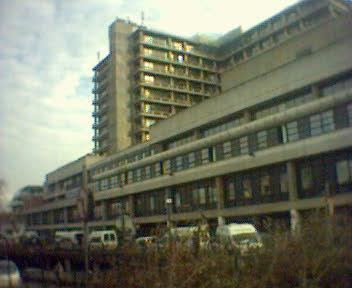Care system Public NHS Opened 1828 Number of beds 839 | Phone +44 20 7794 0500 Founded 1828 | |
 | ||
Affiliated university University College LondonMiddlesex University Emergency department Yes Accident & Emergency Hours Open today · Open 24 hoursThursdayOpen 24 hoursFridayOpen 24 hoursSaturdayOpen 24 hoursSundayOpen 24 hoursMondayOpen 24 hoursTuesdayOpen 24 hoursWednesdayOpen 24 hoursSuggest an edit Similar University College London, Barnet General Hospital, Great Ormond Street Ho, Chelsea and Westmins, North Middlesex Hospital | ||
Cockroaches royal free hospital
The Royal Free Hospital (also known simply as the Royal Free) is a major teaching hospital in Hampstead, London. The hospital is part of the Royal Free London NHS Foundation Trust, which is a member of the UCL Partners academic health science centre and also runs services at Barnet Hospital, Chase Farm Hospital and a number of other sites.
Contents
- Cockroaches royal free hospital
- Introduction to the cath lab at the royal free hospital
- History
- Royal Free disease
- MMR vaccine controversy
- High level isolation unit
- References
It was rated 'excellent' for quality of services and 'good' for quality of financial management by the Healthcare Commission in 2009.
The nearest London Underground station is Belsize Park, and the hospital is situated very near Hampstead Heath station on the London Overground.
Introduction to the cath lab at the royal free hospital
History
The Royal Free Hospital was founded in 1828 by the surgeon William Marsden to provide, as its name indicates, free care to those of little means. It is said that one evening, Marsden found a young girl lying on the steps of St. Andrew's Church, Holborn, dying from disease and hunger and sought help for her from one of the nearby hospitals. However, none would take the girl in and she died two days later. After this experience Marsden set up a small dispensary at 16 Greville Street, Holborn, called the London General Institution for the Gratuitous Care of Malignant Diseases. A royal charter was granted by Queen Victoria in 1837 after a cholera epidemic in which the hospital had extended care to many victims. As demand for in-patient facilities increased, it was constituted as the Royal Free Hospital, and moved to Gray's Inn Road in the 1840s. Another building in Liverpool Road, Islington, was used as an isolation hospital. Marsden also founded the Free Cancer Hospital in Westminster in 1851, renamed The Royal Marsden Hospital in 1954. In 1974 the Royal Free facilities at Islington and Holborn were combined and moved to the current 12-storey cruciform tower block, built on the site of the former Hampstead General Hospital and the North Western Fever Hospital.
The hospital houses part of the UCL Medical School and its associated medical research facilities. The Royal Free Hospital School of Medicine, since August 1998 a part of the UCL Medical School, was the first to train female doctors in the United Kingdom; the Royal Free Hospital was the first teaching hospital in London to admit women for training.
Significant advances in the fields of liver medicine (hepatology) and transplantation; renal disease and dialysis; haematology and haemophilia have been made at the Royal Free, and the trust now treats all patients needing dialysis in north and central London. The professorial department of liver medicine is recognised as one of the leading research units of its type in the world. It was founded by Professor Dame Sheila Sherlock.
The Royal Free was the first hospital in the UK to appoint a consultant in HIV medicine, in 1989. Dr. Margaret Johnson, a specialist in thoracic medicine, built the Royal Free Centre for HIV Medicine, which is at the forefront of treatment of HIV-AIDS. The out-patients' centre was opened in 1992 by the actor Sir Ian McKellen and is named after the actor Ian Charleson. Its garden, where patients can relax, was opened by Elton John in 2003.
Royal Free disease
In 1955 an apparent outbreak of an infectious illness categorised with a fever and subsequent persisting fatigue affected 292 members of staff and forced the hospital's closure between 25 July and 5 October. In the 1980s there was some debate as to whether the episode was of an infectious cause, or just an example of mass hysteria. The outbreak turned out to be a notable case in the UK of myalgic encephalomyelitis and resulted in the coining of that disease name.
MMR vaccine controversy
In February 1998, the Royal Free held a press conference to coincide with the publication in The Lancet of a paper by Andrew Wakefield who claimed to have found a possible link between the MMR vaccine and autism. This started a controversy which led to a crisis in public confidence over MMR and a fall in uptake of the vaccine. Wakefield left the medical school in October 2001 and was later struck off the UK medical register by the General Medical Council following an investigation by The Sunday Times newspaper into the MMR issue.
High-level isolation unit
The Royal Free Hospital has a high-level isolation unit equipped to treat highly infectious diseases such as Ebola virus disease. In 2014, the British nurse William Pooley was successfully treated for Ebola virus disease at the unit. In December 2014, Pauline Cafferkey, a British health worker diagnosed with Ebola in Glasgow was transferred to the unit for treatment.
The unit has also previously been used to treat a patient with Crimean-Congo haemorrhagic fever.
